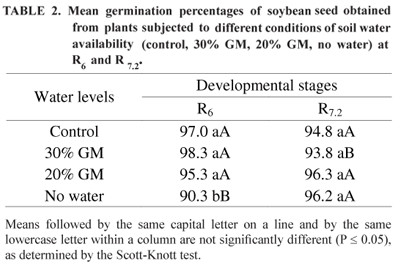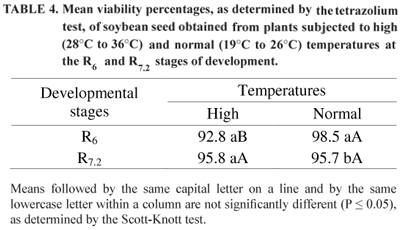Hot and dry weather conditions during soybean [Glycine max (L.) Merrill] seed maturation can cause forced maturation of the seed, resulting in the production of high levels of green seed, which may be detrimental to seed germination. These stressful conditions were imposed on soybean plants during seed maturation to investigate the production of green seeds and seed quality. Plants of the CD 206 cultivar were grown in a greenhouse until the R5.5 growing stage and then transferred to phytotrons at R6 and R7.2 for stress induction. Plants were subjected to two temperature regimes, high (28ºC to 36ºC) and normal (19ºC to 26ºC), and four soil water availability conditions, control (adequate water supply), 30% gravimetric moisture (GM), 20% GM and no water supply. Seed were harvested at R9. Green seed percentages and 100-seed weights from the lower, middle and upper thirds of each plant were determined. Seed quality was assessed by germination, tetrazolium (viability and vigor) and electrical conductivity tests. Occurrence of green seed varied from 9% to 86%, depending on the severity of the stresses imposed. High temperature, coupled with no water supply at R6, resulted in a pronounced occurrence of green seeds. There was no difference in the percentage of green seeds among the plant segments. Seed quality was negatively affected by the incidence of green seeds. A procedure for screening soybean genotypes in a phytotron for their tolerance and/or susceptibility to the production of green seeds was developed.
Glycine max; seed quality; temperature stress; water stress












